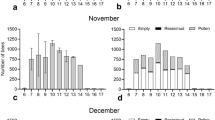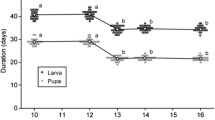Abstract
The effect of physiological state (hunger) and experience on the responsiveness of the aphid parasitoid, Lysiphlebus testaceipes(Cresson), to clean and honeydew-contaminated host plants was investigated in laboratory bioassays. Both fed and unfed parasitoids spent significantly longer examining honeydew-contaminated plants compared to uncontaminated controls, but the presence of honeydew did not influence attack latency (i.e., the speed with which naive parasitoids found and attacked hosts). Hunger, however, had a significant negative effect on attack latency, presumably as a result of a physiologically based shift from host- to food-location behavior in starved parasitoids. The parasitoid 's response to clean plants was significantly increased as a result of classical conditioning procedures, whereas the response to honeydew-contaminated plants was not.
Similar content being viewed by others
References
Ayal, Y. (1987). The foraging strategy ofDiaeretiella rapae I. The concept of the elementary unit of foraging.J. Anim. Ecol. 56: 1057–1068.
Bouchard, Y., and Cloutier, C. (1984). Honeydew as a source of host-searching kairomones for the aphid parasitoidAphidius nigripes (Hymenoptera: Aphidiidae).Can. J. Zool. 62: 1513–1520.
Buchanan, G., and Bitterman, M. E. (1988). Learning in honeybees as a function of amount and frequency of reward.Anim. Learn. Behav. 16: 247–255.
Budenberg, W. J. (1990). Honeydew as a contact kairomone for aphid parasitoids.Entomol. Exp. Appl. 55: 139–147.
Cardé, R. T., and Lee, H.-P. (1989). Effect of experience on the responses of the parasitoidBrachymeria intermedia (Hymenoptera: Chalcididae) to its host,Lymantria dispar (Lepidoptera: Lymantriidae), and to kairomone.Ann. Entomol. Soc. Am. 82: 653–657.
Cloutier, C., and Bauduin, F. (1990). Searching behavior of the aphid parasitoidAphidius nigripes (Hymenoptera: Aphidiidae) foraging on potato plants.Environ. Entomol. 19: 222–228.
de Jong, R., and Kaiser, L. (1991). Odor learning byLeptopilina boulardi, a specialist parasitoid (Hymenoptera: Eucoilidae).J. Insect Behav. 4: 743–750.
Dmoch, J., Lewis, W. J., Martin, P. B., and Nordlund, D. A. (1985). Role of host-produced stimuli and learning in host selection behavior ofCotesia (=Apanteles) marginiventris (Cresson).J. Chem. Ecol. 11: 453–463.
Drost, Y. C., Lewis, W. J., Zanen, P. O., and Keller, M. A. (1986). Beneficial arthropod behavior mediated by airborne semiochemicals. I. Flight behavior and influence of preflight handling ofMicropletis croceipes (Cresson).J. Chem. Ecol. 12: 1247–1262.
Eller, F. J., Tumlinson, J. H., and Lewis, W. J. (1988). Beneficial arthropod behavior mediated by airborne semiochemicals. II. Olfactometric studies of host location by the parasitoidMicropletis croceipes (Cresson) (Hymenoptera: Braconidae).J. Chem. Ecol. 14: 425–434.
Gardner, S. M., and Dixon, A. F. G. (1985). Plant structure and the foraging successof Aphidius rhopalosiphi (Hymenoptera: Aphidiidae).Ecol. Entomol. 10: 171–179.
Grasswitz, T. R. (1992).Aspects of Semiochemical-Mediated Foraging Behaviour in Lysiphlebus testaceipes (Cresson) (Hymenoptera: Aphidiidae), Ph.D. dissertation, University of California, Riverside.
Grasswitz, T. R., and Paine, T. D. (1993). Effect of experience on in-flight orientation to host-associated cues in the generalist parasitoidLysiphlebus testaceipes. Entomol. Exp. Appl. (In press).
Hågvar, E. B., and Hofsvang, T. (1989). Effect of honeydew and hosts on plant colonization by the aphid parasitoidEphedrus cerasicola.Entomophaga 34: 495–501.
Hågvar, E. B., and Hofsvang, T. (1991). Aphid parasitoids (Hymenoptera, Aphidiidae): Biology, host selection and use in biological control.Biocontrol News Inform. 12: 13–41.
Kester, K. M., and Barbosa, P. (1991). Postemergence learning in the insect parasitoid,Cotesia congregata (Say) (Hymenoptera: Braconidae).J. Insect Behav. 4: 727–742.
Kimble, G. A. (1961).Hilgard and Marquis' Conditioning and Learning, Appleton-Century-Crofts, New York.
Lewis, W. J., and Tumlinson, J. H. (1988). Host detection by chemically-mediated associative learning in a parasitic wasp.Nature 331: 257–259.
Lewis, W. J., Vet, L. E. M., Tumlinson, J. H., van Lenteren, J. C., and Papaj, D. R. (1990). Variations in parasitoid foraging behavior: Essential element of a sound biological control theory.Environ. Entomol. 19: 1183–1193.
Lowes, G., and Bitterman, M. E. (1967). Reward and learning in the goldfish.Science 157: 455–457.
McAuslane, H. J., Vinson, S. B., and Williams, H. J. (1991). Influence of adult experience on host microhabitat location by the generalist parasitoid,Campolelis sonorensis (Hymenoptera: Ichneumonidae).J. Insect Behav. 4: 101–113.
Miller, N. E. (1967). Certain facts of learning relevant to the search for its physical basis. In Quarton, G. C., Melnechuk, T., and Schmitt, F. O. (eds.)The Neurosciences: A Study Pro- gram, Rockefeller University Press, New York.
SAS Institute Inc. (1988).SAS/STAT User's Guide, Release 6.03 Edition, SAS Institute, Cary, NC.
Sheehan, W., and Shelton, A. M. (1989). The role of experience in plant foraging by the aphid parasitoidDiaeretiella rapae (Hymenoptera: Aphidiidae).J. Insect Behav. 2: 743–759.
Stary, P. (1988). Aphidiidae. In Minks, A. K., and Harrewijn, P. (eds.),World Crop Pests. Aphids. Their Biology, Natural Enemies and Control, Vol. 2B, Elsevier, Amsterdam, pp. 171–184.
Strand, M. R., and Vinson, S. B. (1982). Behavioral response of the parasitoidCardiochiles nigriceps to a kairomone.Entomol. Exp. Appl. 31: 308–315.
Vet, L. E. M. (1983). Host habitat location through olfactory cues byLeptopilina clavipes (Hartig) (Hym., Eucoilidae), a parasitoid of fungivorousDrosophila: The influence of conditioning.Neth. J. Zool. 33: 225–248.
Vet, L. E. M., and van Opzeeland, K. (1984). The influence of conditioning on olfactory micro- habitat and host location inAsobara tabida (Nees) andA. rufescens (Foerster) (Braconidae: Alysiinae) larval parasitoids of Drosophilidae.Oecologia 63: 171–177.
Vet, L. E. M., and Schoonman, G. (1988). The influence of previous foraging experience on microhabitat acceptance inLeptopilina heterotoma.J. Insect Behav. 1: 387–392.
Vet, L. E. M., Lewis, W. J., Papaj, D. R., and van Lenteren, J. C. (1990). A variable-response model for parasitoid foraging behavior.J. Insect Behav. 3: 471–490.
Author information
Authors and Affiliations
Rights and permissions
About this article
Cite this article
Grasswitz, T.R., Paine, T.D. Influence of physiological state and experience on the responsiveness ofLysiphlebus testaceipes (Cresson) (hymenoptera: aphidiidae) to aphid honeydew and to host plants. J Insect Behav 6, 511–528 (1993). https://doi.org/10.1007/BF01049529
Accepted:
Issue Date:
DOI: https://doi.org/10.1007/BF01049529




